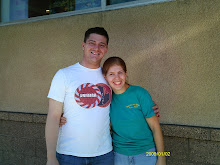Koreans are known for their impecable work ethic. Over here the addage about how differently men and women work might sound like this: "Other nations work from sun to sun, but a Korean's work is never done." Not only do they work hard, but they expect their children to work just as hard. From what I hear from other teachers as well as students, some parents expect their children to go to regular public Korean school, where they learn core subjects, and also expect them to attend a hogwan after that. Many students don't finish their class day until after 8:30pm--and this doesn't include private study or homework.
A hogwan is a private school; its focus is only one subject--in our case, the English language. The hogwan that I teach in is called Learning Well Institute (LWI). These are much smaller than regular schools and usually not affiliated with any church or religious organization (unlike many private schools in the US). Having said that, however, the hogwan seems to have a greater amount of freedom in subject matter and structure than a normal school. Because its focus is language, we cater to a range of different age groups, from Kindergarten all the way through adults. Lauren teaches Kindergarteners. Andy has a student who is fluent in English and only needs an hour of conversation to keep his mind active in the language. I have an intermediate adult class whose focus is geared towards adult interests.
I don't know how big they can get, but our hogwan is extremely small in comparrison to the schools that I have worked in or attended back in San Antonio. The school that I graduated from, Alamo City Christian Academy, had 420 students at its peek in 2000. Believers Academy averaged 120 students when I worked there in 2008 and 2009. Andy and Brandon tell me that we have 100 students in our hogwan, give or take. Not all of these students are in the building or in class all the time, so it feels like much less than 100. Many only come for one or two classes. The adults, for example, are only here for 50 minutes three days a week.
The size of staff is another indication if the smallness of the school. Alamo City had close to 40 or 50 teachers (about a 1-10 ratio) when I went there. Believers Academy had about half that at close to 23 (including part-timers), with two administrators and three senior teachers. LWI has three administrators, all of whom teach something, three full-time teachers, and one part-time, a total of 7. BA helped to prepare me for this environment because there I felt like I and one other teacher made up the secondary English department. Here, however, I feel like Andy, Brandon, and myself are not just a department but are the entire school.
Because we are primarily an after school program, we start later in the day. They've been giving me a break this week in order to adjust to life in a foreign country (so I've been getting there at 2:30), but usually the start time for Andy and Brandon (and I suspect for me, too, starting next week) I is 12:30 on MWF and 11:30 on T, Th. We have three+ hours to prepare for classes and then we teach until 7:30 or 8:30. One of the teachers, Pam, is part time and comes in sometime after we do and leaves probably before us. My schedule looks something like this:
1st-3rd grade class from 3:30-4:20;
5-6th grade class from 4:30-5:20;
maybe an hour break;
(on MWF) middle school writing class from 6:20-6:40;
break;
(on MWF) adult intermediate class from 7:30-8:20.
The first two classes are the same on Tuesday and Thursday. But instead of the writing or adult classes, I've been teaching a two-hour conversation class at a high school called Jungsanat a high school called Jungsan, as a substituting for my director. The hardest part about the schedule for me is how late we get out of work. The coolest part is that I don't have to worry about sleeping through any of my classes! I can get up at 8 or 8:30 and have some time to myself before I have to go to work.
The schedule reminds me a lot of what I had working at Believers Academy. I had a wide range of students and abilities in each class, as well as different grades for each class taught. I taught 5-6th together and went all the way up to 9th grade. Here at Learning Well, I still have that range. At BA, we had a University Model system where there was a different schedule on Tuesdays and Thursdays than on Monday, Wednesday, or Friday. Classes were mainly a la carte: you paid for and attended the classes that you wanted. Many students only came MWF. Some students in fith and sixth grade, for example, didn't come to History because it was on Tuesday and Thursday. The same is true with Learning Well. With the exception of my first two classes, I see different students on T and Th than I do on MWF. Because of my work at BA, these aren't foriegn concepts to me. It's amazing how I can see God preparing me for this even two years ago when I was in the States.
Subscribe to:
Post Comments (Atom)

No comments:
Post a Comment